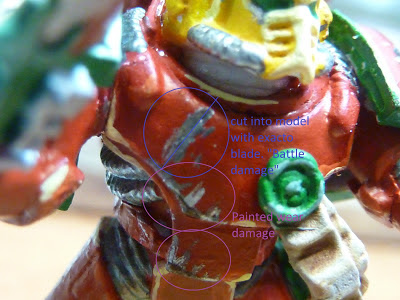But... There are lots of ways to do battle damage, and a lot more ways to overdo battle damage.
Such as this older Land Raider. you can see the silver's just been splashed around a little, overbrushed very badly and as a result, the model looks horrid.
So, this means that some level of subtlety must be necessary for your Marines, surely? I mean, sure. They're going to have battle damage, they're constantly fighting, but they can't Never have a new paint job.
So, painting armour becomes about patience and restraint, and less about making the marine look like he just took a bath in acid. and bases. then water.
Note, you could actually make your metal models look like they took a bath in acid, but placing models in hydrogen peroxide is a bit of a dumb move - much like playing Dark Angels Flyers.
So, I've thrown three terms up: Subtlety, Patience and restraint. These could be shortened to "Discretion". What do I mean by this?
Discretion could be defined as: "The Quality of Behaving in such a way as to avoid causing offence." Lemme tell you, scratched up armour is pretty offensive.
So, behaving in a way that you avoid making armour damage that is garish (out of place) but enough that one will notice it as intentional. Enter, Blood angles assault marine:
Of course, you may not agree that my Assault marine is of a good battle damage quality. That's fine. but we'll still rely on it as our example.
You'll immediately notice 3 things about the battle damage on this models armour (note that at this stage, the model has only had minor highlighting done.)
- The damage is in one area. That is, the chest plate and abdominal plate, off to the left.
- This damage is very much intentional.
- I have not dry brushed at all.
Let's take a closer look:
The battle damage has not been disturbed at this stage, but note that the model is "Finished."
The three distinct damages are obvious here. They can be split into two types:
1. "Battle damage"
2. "Wear damage"
Mostly, people have a lot of wear damage and call it "battle damage".
Wear occurs mostly on parts of metal that are handled often. If anyone reading has metal models, they will know exactly what I mean. So, when making wear damage, make sure that you're brushing corners and areas that would get touched. (for example, the ladders that a space marine climbs to get atop their Rhino.)
 |
| Excuse my incredible paint skills. |
Alone the chest, there's another scratch which isn't obviously a place where wear would occur. In this case, the damage is cut into the armour (literally cut, as I cut the resin.) and so is "Battle damage".
Another example of extreme wear damage is on the helm of this model, where I would imagine the marine constantly removing and replacing his helmet with his off hand (the one without the sword) and so this is where the wear would occur.
In this case, the damage is filed onto the model, even though it is not battle damage. This is because the part of armour here would wear much faster than the chest plates, which are removed far less often. (even then, this helmet is almost overdone and unfortunately, has a garish appearance.)
In the end, battle damage made with discretion has allowed me to create a model with much more believable scrapes and dings in his armour. So, in future, remember: when painting battle damage, discretion and patience is everything.
